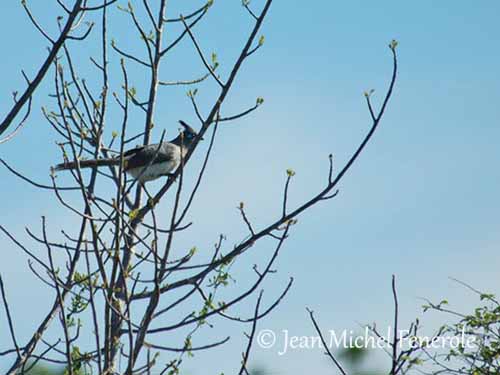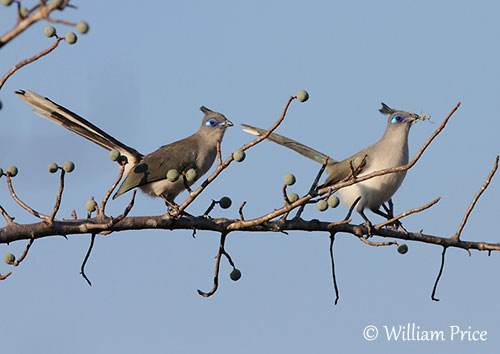
Fr: Coua de Verreaux
Ang: Verreaux’s Coua
All: Breitschopf-Seidenkuckuck
Esp: Cúa de Verreaux
Ita: Cua di Verreaux
Nd: Grijze Coua
Sd: verreauxkoua
Mal: Arefy, Tivoka
Photographers:
Jean Michel Fenerole
Photos d’Oiseaux du monde
William Price
PBase-tereksandpiper & Flickr William Price
Text by Nicole Bouglouan
Sources:
HANDBOOK OF THE BIRDS OF THE WORLD vol 4 by Josep del Hoyo-Andrew Elliott-Jordi Sargatal - Lynx Edicions - ISBN: 8487334229
Cuckoos of the World Par Johannes Erritzøe, Clive F. Mann, Frederik Brammer, Richard A. Fuller – Editeurs A&C Black, 2012 – ISBN: 1408142678, 9781408142677
The Cuckoos Par Robert B. Payne – Editeur : OUP Oxford, 2005 – ISBN : 0191513555, 9780191513558
Birds of Madagascar: A Photographic Guide Par Pete Morris, Frank Hawkins – ISBN: 0300077556, 9780300077551- Editeur: Yale University Press, 1998
CREAGUS - CUCKOOS & ALLIES - Cuculidae

Verreaux’s Coua
Coua verreauxi
Cuculiformes Order – Cuculidae Family
INTRODUCTION:
The Verreaux’s Coua is endemic to Madagascar where it is restricted to sub arid thorn scrub in SW Madagascar.
It feeds on insects and small vertebrates such as geckos or chameleons, but it also takes some fruits in trees. It is usually seen alone or in pairs, and in small family groups after the breeding season.
The Verreaux’s Coua is threatened by wood-cutting for charcoal production, and hunting pressure. It is currently listed as Near Threatened.
DESCRIPTION OF THE BIRD:
Biometrics:
Length: 34-38 cm
Weight: M: 98g – F: 97-101g
The Verreaux’s Coua adult has grey-green upperparts. The long, glossy blue tail has white tips, except on central rectrices. The flight-feathers are glossy greenish-blue.
The underparts are pale grey on throat and breast, becoming whitish on belly and flanks, but we can see a small pinkish-brown area on the latter.
The head is grey tinged green, with prominent grey, dark-tipped crest usually held backwards, upright or forwards. There is a blue patch of bare skin around the eye, mostly ultramarine blue around and in front of eye, and bright sky blue behind the eye. The eyering is blue.
The small bill is black. The eyes are dark brown to grey-brown. Legs and feet are black.
Male and female are similar.
The juvenile resembles adult but it has shorter crest and narrower, more pointed tail feathers with reduced white tips.

RANGE:
The Verreaux’s Coua occurs in S and SW Madagascar, from S of Toliara to E of Cape Ste. Marie.
HABITAT:
The Verreaux’s Coua frequents sub arid thorn scrub, especially Euphorbia and Alluaudia brush, both on sandy and calcareous soils, from sea-level to 225 metres.
CALLS AND SONGS: SOUNDS BY XENO-CANTO
The Verreaux’s Coua gives a loud, descending series of squawking calls “crick-crick-crick-corick-corick” usually at dusk and from tree tops. It may be followed by a second series of descending growls “gwuorr-gwuorr-gorr-gorr-gor-gor” sometimes given separately.
We can also hear loud growl “quark quark” followed by soft, descending “coo coo”.
BEHAVIOUR IN THE WILD:
The Verreaux’s Coua feeds on insects and small vertebrates such as geckos and small chameleons. It also consumes fruit of Cassia.
It is an active arboreal forager, searching for food in bushes or trees. It may descend to the ground to catch a prey, but it is usually perched motionless high in bush or tree.
The Verreaux’s Coua is often seen alone or in pairs, but after the reproduction, it usually occurs in small family groups.
Like other couas, it often sunbathes with fluffed body feathers.

The breeding behaviour is unknown. But the long, white-tipped tail, the crest and the bright blue head pattern are probably enhanced during the displays.
The Verreaux’s Coua is resident on the island.
It flies with rapid wingbeats interspersed with glides.
REPRODUCTION OF THIS SPECIES:
The breeding season apparently occurs between October and April, with active nests recorded in October, January and April. The males sing in November.
The nest made with sticks is a shallow bowl-shaped structure or a platform, and the cup is sometimes lined with lichens. It is usually placed between 1,5 and 4 metres above the ground, often in Euphorbia.
There is no information on clutch size, incubation, nestling and fledgling periods, but both parents apparently feed the young.
PROTECTION / THREATS / STATUS:
The Verreaux’s Coua is threatened by wood-cutting for charcoal production, especially along roads and around main towns, and hunting pressure. It is also vulnerable to predation by Grandidier’s vontsira (Galidictis grandidieri), Black Kite and Madagascar Buzzard.
The population is suspected to be declining due to degradation of the habitat.
The Verreaux’s Coua is currently listed as Near Threatened.